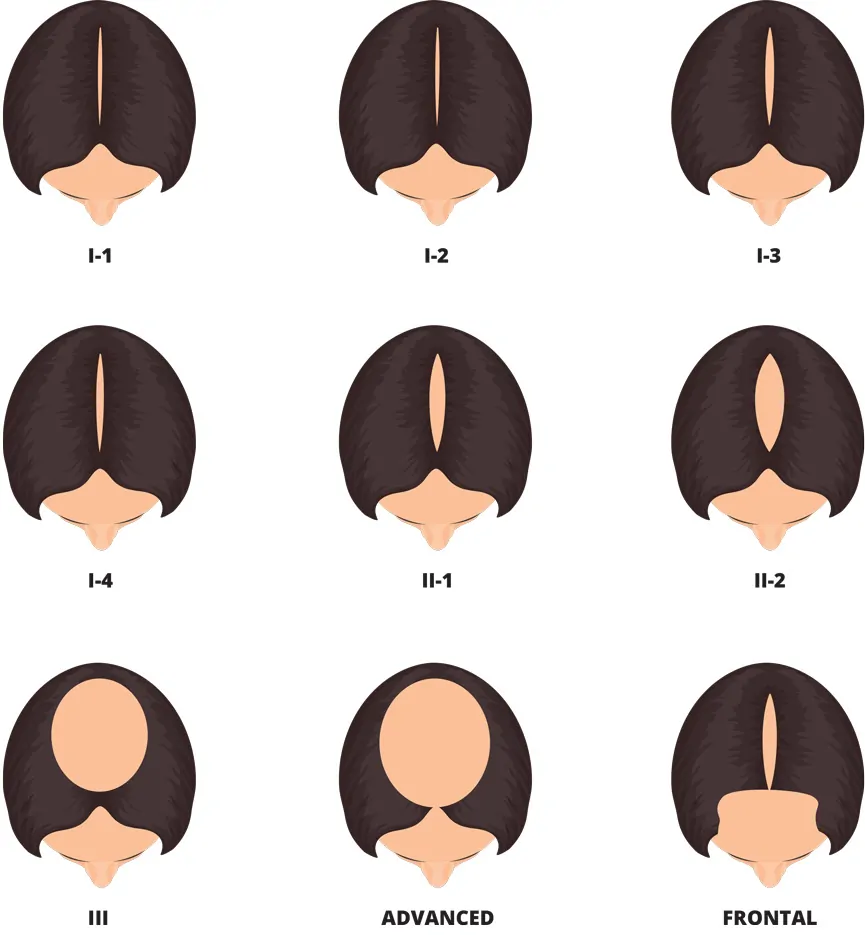Female Pattern Hair Loss (FPHL), medically termed androgenetic alopecia in women, is the leading cause of progressive thinning and reduced hair density in females worldwide. It is a chronic condition that usually begins with gradual thinning over the midline and crown of the scalp rather than a receding frontal hairline, as is typical in men.
The psychosocial burden is profound: women often associate hair with beauty, youth, and confidence. Thus, FPHL not only affects external appearance but may also lead to depression, anxiety, and reduced quality of life.
Classification of Hair Loss in Women
Hair loss in women can present with different patterns. Proper classification helps guide treatment.
| Type of Hair Loss | Clinical Features | Occurrence in Women |
|---|---|---|
| Female Pattern Hair Loss (FPHL) | Diffuse thinning across the scalp, especially at the crown and part line; hair shaft miniaturization. | Very common |
| Male Pattern Distribution in Women (AGA) | Marked thinning at the crown and frontal hairline; progressive miniaturization of androgen-sensitive follicles. | Frequent |
| Localized Alopecia (Alopecia Areata / Traumatic) | Well-defined patches of baldness; autoimmune, traumatic, or scarring causes. | Less common |
Causes of Female Pattern Hair Loss
FPHL results from a combination of hormonal, genetic, and environmental factors.
- Hormonal Imbalances: Increased androgens (testosterone, DHT) accelerate follicle miniaturization; estrogen decline after menopause worsens the effect.
- Genetic Predisposition: Women with a family history of pattern hair loss are more susceptible.
- Life Stages: Menopause and postpartum hormonal shifts may unmask latent androgenetic alopecia.
- Stress & Psychological Factors: Chronic stress alters cortisol and disrupts the hair cycle.
- Nutritional Deficiencies: Deficit in iron, vitamin D, zinc, or biotin impairs follicular health.
- Chronic Diseases: Polycystic ovary syndrome (PCOS), thyroid disorders, metabolic syndrome.
Clinical Features & Symptoms
- Progressive Thinning: Most visible on the crown and central scalp.
- Widening Part Line: A hallmark of female pattern baldness.
- Recession of Frontal Hairline: Less common but may appear in advanced cases.
- Excessive Shedding: Daily hair loss exceeding normal range.
- Laboratory Findings: Hormonal imbalances, iron deficiency, or thyroid abnormalities may be detected.

Treatment Modalities
Management is individualized. In early stages, medical therapies may stabilize hair loss. In more advanced cases, regenerative treatments and hair transplantation are considered.
| Treatment Option | Description | Advantages | Limitations |
|---|---|---|---|
| Medical Therapies | Topical minoxidil, anti-androgen medications, hormone regulation, nutritional supplementation. | Slows progression; strengthens existing follicles. | Not curative; requires continuous use; limited effect in advanced baldness. |
| PRP & Stem Cell Therapies | Platelet-rich plasma or mesenchymal stem cell injections. | Improves thickness and quality of existing hair. | Requires multiple sessions; insufficient for extensive baldness. |
| Hair Transplantation (FUE/DHI) | Transfer of permanent donor follicles from the nape to thinning areas. | Permanent, natural-looking density; effective in advanced cases. | Surgical; requires skilled surgeon and sufficient donor supply. |
| Supportive Therapies | Laser therapy, mesotherapy, medical hair care products. | Enhances scalp health; complements other treatments. | Not effective as a stand-alone therapy for bald patches. |
Hair Transplantation in Women
Indications
- Advanced hair thinning resistant to medical therapy
- Adequate donor hair supply
- Desire for permanent, natural density
Step-by-Step Procedure
- Pre-Operative Assessment: Hormonal testing, trichoscopy, scalp analysis.
- Local Anesthesia: Ensures comfort during the procedure.
- Donor Harvesting: Follicles taken from the occipital scalp.
- Channel Creation: Sapphire microblades used for precision.
- Implantation: Follicles placed at natural angles to replicate hair growth patterns.
Recovery & Timeline
- Days 1–10: Redness, scabbing, and mild swelling. Follicles remain fragile.
- Weeks 2–4: Temporary shedding (“shock loss”) occurs.
- Months 3–6: Initial regrowth becomes visible.
- Months 6–12: Density increases significantly.
- After 12 Months: Final, stable, and natural-looking results.
Cost Considerations
Hair transplant cost in women depends on:
- Severity of hair loss
- Number of grafts required
- Technique (FUE vs. DHI)
- Surgeon’s expertise
- Clinic infrastructure
Due to Ministry of Health regulations, exact prices cannot be published online. For consultation and quotation: +90 212 241 46 24
Frequently Asked Questions (FAQ)
Can female pattern hair loss be completely stopped?
No. Medical therapy slows progression, but hair transplantation is the permanent solution.
Are the results natural?
Yes. With FUE/DHI, follicles are implanted at natural angles, ensuring undetectable outcomes.
How long is the recovery?
Healing takes ~10 days; full results are seen at 12 months.
Is unshaven hair transplant possible for women?
Yes. Partial trimming of the donor area allows an unshaven technique.
Does scarring occur?
No visible scars with FUE/DHI. FUT may leave a linear scar, rarely used today.

